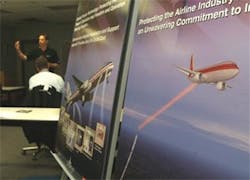Future Unclear for Plan to Arm Planes
Two companies working for the government say they have successfully tested systems to defend passenger airplanes against shoulder-fired missiles.
BAE Systems and Northrop Grumman both say they will meet the government's deadline of producing a workable system by January. It is unclear whether Congress or the Bush administration will require airlines to use the technology and, if they do, who will pay the multibillion-dollar tab for deployment and maintenance.
The chairman of the House Transportation and Infrastructure subcommittee on aviation is leading the push in Congress to equip U.S. planes with the technology. A bill by Rep. John Mica, R-Fla., would require the systems on the largest airliner, the Airbus super-jumbo A380, which is supposed to go into service late next year. The legislation, if it became law, would affect any A380 that flew in the United States.
Mica plans to introduce a bill to require systems on some planes that may pose a particular risk, such as international flights. The government may pay for part of the systems, he said.
"I don't believe terrorists will be successful in taking down a domestic aircraft, but I think we're overdue for international aircraft to be hit," Mica said.
Congress has agreed to pay for developing technology to counter lightweight rocket launchers, but balked at proposals to spend the billions needed to protect all 6,800 commercial U.S. airliners.
No passenger plane has ever been downed by a shoulder-fired missile outside of a combat zone. But terrorists linked with al-Qaida are believed to have fired two SA-7 missiles that narrowly missed an Israeli passenger jet after it took off from Mombasa, Kenya, in November 2002.
Under pressure from Congress, the Homeland Security Department last year gave Northrop and BAE $45 million each to adapt military missile defense systems so they can be used by airlines. Military systems require too much maintenance - and fire by mistake too often - to be used on a passenger airliner.
BAE and Northrop Grumman conducted flight tests on Wednesday and Thursday to demonstrate that their prototypes were aeronautically sound and would not impair the planes' ability to fly.
An American Airlines Boeing 767 outfitted with BAE's Jeteye system successfully flew figure-eights over Alliance Field in Fort Worth, Texas, while Northrop Grumman's Guardian system was tested Wednesday on an MD-11 jet that flew around after taking off from Mojave Airport in California.
The Guardian system jammed 177 simulated missiles in a separate test, said Northrop spokeswoman Katie Lamb.
Both Northrop and BAE systems use lasers to jam the guidance systems of incoming missiles, which lock onto the heat of an aircraft's engine.
Northrop and BAE are required to come up with systems that will cost less than $1 million each to install. They also must require far less maintenance than the military versions.
The Homeland Security Department set a standard of an average of 3,000 hours of flight before the system fails and requires repairs - 10 times longer than the military's requirement.
John Kubricky, Homeland Security's director of director of systems engineering and development, said the tests so far have been encouraging. "They still have a couple of hurdles to get over," he said.
Though shoulder-fired missiles don't pose a threat in the United States right now, the Bush administration doesn't want to be caught short without a solution if they do threaten airliners, Kubricky said.
When the testing is complete, Homeland Security will present a report to Congress outlining its alternatives for deploying the systems.
Airlines caution that the systems will consume a large chunk of the limited funds that can be spent to defend airplanes from terrorists.
"It's a huge expenditure of resources to deal with one type of threat," said John Meanen, executive vice president for the Air Transport Association, which represents major airlines. "We have to ask, 'Are there better ways of doing this?'"
Raytheon, for example, said it has a developed a ground-based system that can be set up around an airport to detect and deter missiles aimed at aircraft. The company argues that its system, called "Vigilant Eagle," would be cheaper than putting a system on every plane.
The largest pilots' union doesn't think that the struggling airline industry should be required to pay for an expensive technology.
"If the federal government wants this thing, the government should pay for this thing," said Bob Hesselbein, chairman of the national security committee for the Air Line Pilots Association.
___
On the Net:
Homeland Security Department: http://www.dhs.gov
BAE Systems: http://www.baesystems.com
Northrop Grumman: http://www.northropgrumman.com
News stories provided by third parties are not edited by "Site Publication" staff. For suggestions and comments, please click the Contact link at the bottom of this page.

